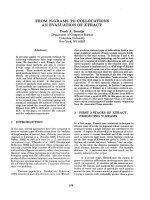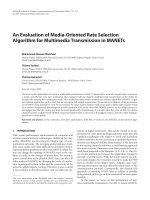an evaluation of e learning websites for english learning accessible to vietnamese learners in terms of motivating students to speak english
Bạn đang xem bản rút gọn của tài liệu. Xem và tải ngay bản đầy đủ của tài liệu tại đây (1.46 MB, 56 trang )
1
Vietnam national university, Hanoi
University of languages and international studies
Faculty of post-graduate studies
LÊ THỊ PHƢƠNG CHUNG
AN EVALUATION OF E-LEARNING WEBSITES FOR
ENGLISH LEARNING ACCESSIBLE TO VIETNAMESE
LEARNERS IN TERMS OF MOTIVATING STUDENTS TO
SPEAK ENGLISH
Đánh giá vấn đề tạo hứng thú cho học viên học nói tiếng Anh trên các trang web
đào tạo tiếng Anh trực tuyến cho ngƣời Việt Nam.
MA. Minor Thesis
Field
: English Teaching Methodology
Code
: 60.14.10
Ha Noi - 2010
2
Vietnam national university, Hanoi
University of languages and international studies
Faculty of post-graduate studies
LÊ THỊ PHƢƠNG CHUNG
AN EVALUATION OF E-LEARNING WEBSITES FOR
ENGLISH LEARNING ACCESSIBLE TO VIETNAMESE
LEARNERS IN TERMS OF MOTIVATING STUDENTS TO
SPEAK ENGLISH
Đánh giá vấn đề tạo hứng thú cho học viên học nói tiếng Anh trên các trang web
đào tạo tiếng Anh trực tuyến cho ngƣời Việt Nam.
MA. Minor Thesis
Field
: English Teaching Methodology
Code
: 60.14.10
Supervisor : Dr. Dƣơng Thi Nụ
Ha Noi - 2010
5
CONTENTS
DECLARATION
ACKNOWLEGEMENT
ABSTRACT
LIST OF ABBREVIATIONS
LIST OF PICTURES AND TABLES
PART I. INTRODUCTION
1.1 Rationale
1.2 Aims of the study
1.3 Significance of the study
1.4 Methods of the study
1.5 Scope of the study
1.6 Design of the study
PART II. DEVELOPMENT
CHAPTER 1. LITERATURE REVIEW
1.1 E-learning and Web-based training
a. Definitions
b. Roles and drawback
c. Types of web-based training
1.2 Motivation in e-learning and motivation to practice speaking online
i.
Definition of motivation and its roles in e-learning
ii.
Types of motivation
iii.
Models of motivation in e-learning
1.3 Web-based training evaluation
1. What is evaluation?
2. Purposes of evaluation
3. Types of evaluation and evaluation approaches
6
4. Procedures of evaluation
CHAPTER II. METHODOLOGY
2.1 Context setting
2.2 Methodology
2.2.1 Program analysis
2.2.2 Survey
CHAPTER III: RESULTS AND DISCUSSIONS
3.1 Program analysis
3.2 Survey results
3.2.1 Part I
3.2.2 Part II
3.2.2.1 Attention
3.2.2.2 Relevance
3.2.2.3 Confidence
3.2.2.4 Satisfaction
CHAPTER IV. SUMMARY OF MAIN FINDINGS AND
RECOMMENDATIONS
4.1 Summary of main findings
4.2 Recommendations
4.2.1 Language content
4.2.2 Practising activities
4.2.3 Instructions
4.2.4 Supporting service
PART III. CONCLUSION
APPENDICES
8
LIST OF PICTURES AND TABLES
Picture 1: Pronunciation lecture
Picture 2: Recording tool
Picture 3: Recorded file in a reading task
Picture 4: Chat rooms
Picture 5: Yahoo conferencing tool
Table 1: The demographics of the targeted population
Table 2: Question 6
Table 3: Question 7
Table 4: Question 8
Table 5: Question 9
Table 6: Question 10
Table 7: Question 11
Table 8: Question 12
Table 9: Question 13
Table 10: Question 14
Table 11: Question 15
Table 12: Question 16
Table 13: Question 17
9
LIST OF ABBREVIATIONS
FTU: Foreign Trade University
CLT: Communicative Language Teaching
10
PART I. INTRODUCTION
1.1 Rationale
“Information technology will bring mass customization to learning too....Workers will be able to keep up to date on techniques in
their field. People anywhere will be able to take the best courses taught by the greatest teachers.” (Bill Gate, 1995)
E-learning in general has been a common term for educators or learners over the world. Without exception, web-based
training with its unlimited learning time and place as well as the cost effectiveness makes itself a good choice for Vietnamese
English learners. Furthermore, thanks to the advancement of technology, this kind of training can also help them enhance their
speaking skill, which can deal with the problem of lacking an English communicative environment in Viet Nam (Nguyen, 2006).
However, according to Eric Parks, a Fair Oak California Web Based Designer, fifty percent of trainees who start web-based
training don‟t finish (Quoted from Jessica, 2000). Besides, a recent report in the Chronicle for Higher Education found that
institutions report dropout rates ranging from 20 to 50 percent for distance learners. (Quoted from Karen). This article also
claimed that the reason for this is lacking motivation, which has a same idea with Thair (2008). This is simply because motivation
is defined as „some kind of internal drive which pushes someone to do things in order to achieve something” (Harmer, 2001,
P.51).
Therefore, this thesis is created to make an evaluation of E-learning Website for English Learning Accessible to Vietnamese
Learners in terms of motivating students to speak English.
1.2 Aims of the study
As referred to before, the evaluation of motivation for speaking for online English learners is an important point that
the web designers or the teachers should take into considerations when delivering a web-based training program for Vietnamese
learners.
In fact, there have been ample studies over the world which raised the theory and implications of web-based training
evaluation. For example, Sammi Chan et al summarized an overview of web-based learning that contains all theories related to
11
this kind of training. In terms of evaluation, Kirkpatrick (2006) developed a model for the evaluation of training programs and
Henry L. Smith and Badrul H. Khan also made a study of Evaluation of an Asynchronous Online Program. Furthermore, ChiaYing and Ya-Ting (2007) researched Criteria for Evaluating English Learning Websites. However, such above studies just focus
on evaluating the overall website which means answering the question: “Is the training program effective or not?” and the skills
in English, i.e. listening, speaking, reading and writing. Actually, there has not been any study that focuses on the motivation to
get learners to speak, especially those in Viet Nam.
Therefore, this study is done to
explore and choose an appropriate evaluation method for this projects
evaluate the speaking motivation of the learners on the web:
and draw theoretical and practical implications for improving the program design.
In order to reach the aims of the study, the two research questions are raised:
(1) To what extent does the program of the website motivate the learners to speak English?
(2) Which implication can be drawn from the evaluation in order to design a better one?
1.3 Significance of the study
The author‟s objective is that this thesis will make a contribution to
Investigating the methods to evaluate a web in terms of motivating the learners to speak English
examining the degree to which a website is able to motivate the learners to speak including particular strengths and
weaknesses of the program
and, the foundation for the design of a new website that promises to be highly-motivating to the learners in speaking English
online, which is anticipated to positively affect dropout rates in this program, in particular, and in e-learning education, in
general.
1.4 Methods of the study
12
The major method of the study is both qualitative and quantitative via such instruments: Questionnaires and semistructured interviews. In order to get the information for these, 150 students in FTU are included as informants.
1.5 Scope of the study
Due to the limited time, this thesis only restricts itself to an e-learning website
() and the
object of the study are the students in the Foreign Trade University, Hanoi, Vietnam. Moreover, this study mainly focuses on
evaluating the online design of the General elementary course in terms of motivating learners to speak or practice speaking
English. Based on that, this study will provide some implications to design a new online course or enhance the online course
studied.
1.6 Design of the study
The study is composed of four chapters: Introduction, Literature review, Results and discussion and Conclusion. Chapter
one begins with a general introduction covering the reasons for choosing the theme, aims, scope, methods and design of the study.
Chapter two deals with the literature review in which the most important notions related to web-based training programs,
motivation to speak online and evaluation methods are explored and discussed. Chapter three is devoted to the analysis of the
training program and the data information conducted by survey questionnaire and interviews carried out with FTU students. The
next chapter summarizes all the results obtained and includes suggestions for further study. And the last chapter is the final
conclusion together with recommendation for further study. Useful appendices can be found at the end of the thesis.
13
PART II. DEVELOPMENT
CHAPTER 1. LITERATURE REVIEW
1.2 E-learning and Web-based training
1.1.1 Definitions
The European Commission defines e-learning, i.e. learning via electronic ('e') means, as "the use of new multimedia
technologies and the Internet to improve learning quality by facilitating access to educational resources and services, as well as
to opportunities for online forums and teamwork initiatives". This means it is the intentional use of networked information and
communications technology in teaching and learning.
In fact, there are a number of other terms that are also used to describe this mode of teaching and learning. They include online
learning, virtual learning, distributed learning, network and web-based learning. Fundamentally, they all refer to educational
processes that utilize information and communications technology to mediate asynchronous as well as synchronous learning and
teaching activities.
In terms of web-based training (WBT), in particular, Khan (2001) claims that it “refers to training delivered in whole or in part
over the Internet‟s World Wide Web.” Having the same idea, Allison Rossett (2001) defines e-learning as: Web-based training
(WBT), also known as e-learning and on-line learning, is training that resides on a server or host computer that is connected to
the World Wide Web.”
In other words, web-based training is a kind of storing instructional materials, including courses, videos, tests and multimedia
materials at a central location that can then be accessed by anyone connected to the Internet, anywhere, at any time.
1.1.2 Roles and drawback
Thanks to its own delivery, web-based training has many advantages to learners. For example, Collin (1999) listed the following
main benefits.
14
Effective: studies show that this form of training is 30 percent more effective at skills transfer and retention than classroom
training.
Convenient: you train in a place and at a time to suit yourself.
Price: you only pay for the tuition, saving on a accommodation, subsistence, travel and opportunity.
One to one: during online sessions, you have a private, personal tutor.
Support: during classes, you can network with your classmates and tutor.
Exam preparation: frequent testing before and after course topics, enabling you to go over topics not fully understood.
On the other hand e-learning has also some possible disadvantages. Most common disadvantages from participant point of view
are (Wools et al., 2002; Robinson and Bawden, 2002; Newman, 2008):
Feeling of isolation – participants may feel isolated from their teacher and/or class mattes, because there are no physical contacts
among participants;
Technology issues – participants must have a computer with access to internet and other adherent equipment (e.g. printer,
loudspeakers). In some places are internet connections inappropriate (e.g. lack of broad and internet). Slow internet connection
could cause frustrations;
Basic computer skills – participants in e-learning must have sufficient level of skills and knowledge of how to use modern ICT
and computers. Some peoples have phobias concerning using computers and modern ICT. Management of computer files and
online software may be difficult for some participants;
Lack of self-discipline and self-motivation – participants with lack of motivation and/or lower lever of self-discipline may fall
behind;
Problems and open dilemmas about most appropriate method of evaluating participants‟ work/success in e-earning process.
1.1.3 Types of web-based training
15
There are four main types of Web-Based Training that are useful in different circumstances. However, most of training
projects combines these types with different materials and information delivery.
Leader-Led or Facilitated Online Learning (Madison, 2000) is a kind of providing guidance and support by an instructor. This
kind is popular at the university level with lots of rooms for essays and open-ended questions.
Advantages:
There is high interactivity with other learners.
Learners have personalized assistance from the instructor.
The training program requires less development time since there‟s a heavy reliance on the skills and experience of the
instructor.
There is a very high completion rate due to personal follow-up by the instructor.
Disadvantages:
This training program requires a skilled instructor online during working hours.
This training program requires a special software package or license.
The ratio of students to instructor should not be more than 20-1 per course.
Self-Paced, Web-based Learning (Barbara, 2002) does not need any instructor because it is well-constructed around formal
lessons which contain performance objectives, motivation, learning activities, feedback, and evaluation.
Advantages
Learners can start when they‟re ready and take as much time as they need to complete.
There is no upper limit on number of students that can be trained at one time.
Disadvantages
This program takes most time and skill to construct. Development time is typically 40 to 60 hours (or more) for each hour
of learning time.
16
There is no interactivity or opportunity to learn from the experience of classmates.
This program is better suited to memorization and mental activities and does not lend itself well to hands-on activities.
Without a Learning Management System (LMS) there is no way to track whether learners have achieved performance
objectives or indeed whether they have completed training or even looked at it.
There is a very low completion rate. People are busy and tend to just drop out unless there are organization incentives to
influence learners.
Online Tutorials are typically in PDF format for documents that is meant to be read online or printed.
Advantages
It is quick to develop and to produce, since they are usually based on existing documentation.
This program does not require an instructor.
It is easy to distribute online or via email.
This program self-paced
This program can be used any time, anywhere.
Disadvantages
There is no interactivity, no feedback, no external motivation.
It‟s a challenge to make users aware that online tutorials exist and to motivate them to use them.
Online tutorials have a very low usage and completion rate. Learners find online tutorials hard to find, hard to print, and
difficult to follow.
Web-Based Electronic Performance Support Systems (EPSS) (Gloria Gery, 1991) is intended as a just-in-time online
instruction in the accomplishment of a short task (say, 5 min.) EPSS often incorporate visual simulations “showing” rather than
“telling”.
Advantages
17
This program can be incorporated into a software product and used like online help.
Just in time and just enough - available any time, anywhere the product is available.
This program is short and therefore more usable and user-friendly in a busy workplace.
Can serve visual or hands-on learners or ESL learners better than a printed manual.
Can replace other forms of training for simple tasks that are neither critical nor frequently performed.
Disadvantages
No interactivity with other learners, no feedback.
Low usage and completion rate. Studies show that when people don‟t have the information they need to complete a task,
they will typically a) ask someone; b) phone someone; c) try to figure it out themselves; d) read the manual.
1.3 Motivation in e-learning and motivation to practice speaking online
1.2.1 Definition of motivation and its roles in e-learning
Motivation has been mentioned by many language theorists and practicing language teachers to explain reasons for
success in learning a second language.
Regarding the issue, there are plenty of definitions of motivation. As stated by Brown (1994:152), motivation is a term
that is used to define the success or the failure of any complex task. Consequently, Wlodkowski states, “Motivation is not only
important because it is a necessary causal factor of learning but because it mediates learning and is a consequence of learning as
well” (Wlodkowski, 1985, p. 4). Furthermore, Cunningsworth (1992, p. 59) also claims “motivation determines the student‟s
level of attention during class, and the assiduity which he does his homework and revises what he has been taught during the
day”.
In short, it cannot be denied that motivation plays a very important part in helping learners learn English in general and
speak English frequently in particular.
1.2.2 Types of motivation
18
There are two main types of motivation, i.e. intrinsic and extrinsic one, which affect students when participating in learning
process. Intrinsic motivation is the completion of a task for the sense of mastery, competence and well being connected to the
work done in class. This means the task motivates itself. Extrinsic motivation is the external reward after completion of the task.
A few examples are grades, recognition from an instructor and promotion or pay raise at work.
In terms of e-learning and the designers‟ perspectives, the second type of motivation that is extrinsic motivator is
uncontrollable. So intrinsic motivator is what they care about when designing such a kind of this training program.
1.2.3 Models of motivation in e-learning
In terms of e-learning, motivation has been considered a matter of design: proper instructional design and provision of
suitable learning activities would engage all learners. There are some main models of motivation in e-Learning as follows.
The first one is Motivational Planner of Del Soldato and Du Boulaym (1995) that includes practical strategies and tactics
to be used depending on the learner‟s motivational state. This means the motivational planer is correlated with the domain-based
planner.
Social Cognitive Learning Theory (SCT) (Bandura, 1986) is the second. So far, the researches based on SCT have showed
the importance of self-efficacy and self-regulation in e-Learning. The former refers to a person‟s belief about his/her capacity to
perform a certain task at a certain level, while the latter refers to the control of the learning activity.
ARCS model is proposed by John M .Keller based on Expectancy Value Theory factors to describe motivation. ARCS
stands for Attention, Relevance, Confidence, and Satisfiction. This kind was used as design principle in order to enhance the
instructional process with motivation.
ARCS Model
Attention
1. Perceptual arousal
Relevance
1. Goal orientation
Confidence
1. Learning requirements
Satisfaction
1. Natural consequence
19
2. Inquiry arousal
2. Motive matching
2. Success opportunity
2. Positive consequence
3. Variability
3. Familiarity
3. Personal control
3. Equity
More specifically, Attention problems occur when students work independently. That is the reason why content in the
online setting must be presented in ways that help or motivate students to attend to the information. The level of relevance any
one student attaches to instruction will differ as a result of their individual background and personal interests. Therefore,
application is needed to promote learning by utilizing students‟ prior knowledge and making sure that personal connections to the
course content are made. Despite the inclusion of more technology in many schools, not all students have the same opportunity to
develop confidence with online learning. When students have experience and know what they are expected to learn they will
begin to develop self-assurance. Hence, the online instructor can facilitate this process by providing manageable structures and
reasonable pacing expectations. Motivating students to continue learning can create satisfaction when the learning experience is
enjoyable and fulfilling. Students need to be made aware of how much they have learned so that the time spent on learning is not
considered a waste.
According to Keller, these categories are devised as follows:
Interest refers to whether the learner's curiosity is aroused and whether this arousal is sustained appropriately over time;
Relevance refers to the learner's perception of personal need satisfaction in relation to the instruction, or whether a highly
desired goal is perceived to be related to the instructional activity;
Expectancy refers to the perceived likelihood of success and the extent to which success is under learner control; and
Satisfaction refers to the combination of extrinsic rewards and intrinsic motivation, and whether these are compatible with the
learner's anticipations (Keller, 1983, p. 395).
20
Besides, there are many other motivation theories and models that have been presented by psychologists. For example,
Maslow‟s hierarchy of needs, Alderfer‟s ERG theory, Herzberg‟s two-factor theory, McCleland‟s achievement model, Malone‟s
intrinsic model, etc. Because the ARCS model is closely related to the learning actions, and it is easy to be detected and used, in
this thesis, the ARCS model is used to present the learner‟s motivation in this study.
1.4 Web-based training evaluation
1.3.1 What is evaluation?
According to the American Society of Training and Development (ASTD), evaluation is any systematic method for gathering
information about the impact and effectiveness of a learning offering. Results of the measurements can be used to improve the
offering, determine whether the learning objectives have been achieved and assess the value of the offering to the organization.
This means evaluation is a systematic process to determine the worth, value, or meaning of something.
According to Nunan (Anthology Series 27, 1991:46), there are some basic differences between evaluation and assessment. For
him, evaluation is a wider term than assessment. While it entails the collection of information on what learners can do in the
target language, it also involves additional processes designed to assist us in interpreting and acting on the result of our
assessment.
1.3.2 Purposes of evaluation
According to Khan (2001) there basically are two reasons for program evaluation. The first one is for decision-making in helping
to improve the program and the other is for accountability, of which the former is more interested by evaluators.
Kirkpatrick identifies reasons for evaluation, i.e.
To justify the existence of the training department by showing how it contributes to the organizations objectives and goals.
To decide whether to continue or discontinue training programs.
To gain information on how to improve future training programs.
Are the facilities satisfactory?
21
Is the schedule appropriate for participants?
Are the aids effective in improving communication and maintaining interest?
Was the coordination of the program satisfactory?
What else can be done to improve the program?
(Kirkpatrick, 1998)
In addition, Fisher and Ruffino (1996) claimed that if a training evaluation is not conducted there are consequences that
may result.
A participant may continue to take courses in which they fail to learn.
Course modifications may not be based on participant outcome data and changes may cause effective training activities to
be replaced by ineffective activities.
Training may be viewed as a wasteful use of resources.
Budget costs that were used could have been put toward effective programs.
In sum, evaluation is described as a feedback tool that allows us to continually improve quality. As a result, this provides
the information needed to improve all aspects of a program.
1.3.3 Types of evaluation and evaluation approaches
As mentioned in his book: Web-based Training, Khan says: There are two types of evaluation: the formative that is conducted to
improve the learning product as it is being developed (during the content development phase) and summative that is conducted as
the final assessment of learning product (during the content delivery phase).
In terms of evaluation approaches, Van der Knapp (quoted in Graham‟s A Guide to the Evaluation of E-learning) identifies 6
major clusters that are:
22
Objectives-oriented approach is based on the idea that the purposes, goals or targets of a project are determined at the start
and the evaluation process should establish whether these have actually been achieved – and, if not, why not.
Management-oriented approach is meant to serve decision makers. Its rationale is that evaluation information is an
essential part of good decision making and that the evaluator can be most effective by focusing the evaluation products on
the needs of managers, policy-makers, administrators and practitioners.
Consumer-oriented approach adopts the perspective of the end user of whatever service or product is being provided. For
this reason they tend to be summative, rather than formative and are concerned primarily with product evaluation.
Expertise-oriented approach is based on the notion of „connoisseurship‟ and criticism and relies on the subjective
professional judgment and expert knowledge of the evaluator.
Participant oriented approach takes the needs of project participants as its starting points. The participants here include:
target groups, stakeholders, learners, project staffs, etc.
Learning-orientated evaluation approach: The operating principle is that the purpose of evaluation is to contribute to
some form of collective or organizational learning.
Based on the above points together with the defined research questions, this study will focus on the consumer-oriented
approach and expertise oriented approach with summative evaluation.
1.3.4 Procedures of evaluation
The process of evaluation consists of several stages, as shown in Figure 1. Although each of the e3Learning websites
(enrich, extend, evaluate learning; e3L) go through all the stages in this overall evaluation process, the exact evaluation design
and schedule varies (Lam & McNaught, 2004). Lam and Naught recommended the five main following steps which can be
presented in the following model:
23
1. Frame
evaluation question
5. Decision &
action!
Evaluation
process
1. Select
strategies
2. Develop a plan
(with timeline)
4. Analyze data
3. Collect
data
The evaluation process (Lam, & McNaught, 2007)
24
CHAPTER II. METHODOLOGY
This chapter includes a justification for the approach the author used in conducting the research. It also provides a
thorough description of how she collected the necessary data as well as the analytical procedure to draw conclusions based on the
collected information. In the first section, she gives a detailed description of context setting and in the following one she put
forward an explanation of her understanding of the methods used in this research.
2.1 Context setting
is a website offering a kind of blended learning with the combination of facilitated online learning
whilst the user works at their own pace with varying levels from elementary to intermediate level in Business English course.
Blended learning means the combination of learning online and learning in class, in which the former provides learners
with the inputs such as: vocabulary, grammar, reading and listening skills meanwhile the latter offers learners the outputs like
speaking and writing skills. Therefore, the objectives of the speaking tab in this website is not to teach the learners to speak but
to help them to improve their fluency in speaking, which will help them greatly in their practical but time-limited speaking
activities in class.
In terms of practising activities, firstly, learners drill from sounds to words and then sentences containing the above
sounds and words, which enhances their fluency in speaking. Those activities are implemented via flash lectures (as shown in the
picture 1).
25
Picture 1: Pronunciation lecture
In each lecture, the aim is for the learners to observe and imitate the way of pronouncing the targeted sound. They are
instructed in pronouncing with the tab: „sounds explanation‟ (the third tab from each side). Then, they practice saying the words
and sentences containing that sound. There are two assisting tabs, i.e. „sounds comparison‟ and „articulators‟, which are basic
information for the learners to start their pronunciation. At this stage, the learners can record their voice by a recording tool
(picture 2) to compare their voice and the native‟s voice in the lecture. Their recorded files are automatically saved in the web and
then checked and commented by online supporters of the courses.
Picture 2: Recording tool
26
Afterwards, they practice this more by reading out loud the recorded files in the listening and reading tab (shown in
picture 3). Once again, they can use the recording tool to check their voice and let it be saved automatically and commented.
Picture 3: Recorded files in reading tasks
Last but not least, they practice their real speaking interaction in written or spoken form with other learners via chat rooms
(picture 4) or yahoo software, a free assisting conferencing tool (picture 5).
27
Picture 4: Chat rooms
Picture 5: Yahoo conferencing tool
28
2.2 Methodology
The thesis is conducted with expertise-oriented and consumer-oriented evaluation approaches (as referred in the Literature
chapter). Therefore, the methodology contains two parts which are program analysis and survey result.
2.2.1
Program analysis
Program analysis is based on the expertise-oriented approach of evaluation, in which the author of this thesis evaluates the
pracitising activities of English speaking on the website in terms of four dimensions of Keller‟s motivation
model for an e-learning program, especially a web-based training program: Attention, Relevance, Confidence and Satisfaction.
2.2.2
Survey
The second part of methodology is based on consumer-oriented approach, in which the learners are considered the
consumers of this program. The main method of this part is survey research which is implemented by two main instruments:
questionnaire and semi-structured interview.
Subjects:
The subjects of the study were 150 third and fourth year students of Foreign Trade University who took part in five
blended or hybrid-learning classes in Smartcom English Training center. Their courses in Smartcom center are Business English
from Elementary to Pre intermediate level, which consist 30 periods in ten weeks. The research was carried out when these
students had only one week left in their courses so they would have already experiences a period of time practicing English
speaking skill on the website: . Moreover, these students were almost third and fourth year students in FTU, so
it was anticipated that they would have their own high need in speaking skill in order to get high salary job. This means that they
have their own high extrinsic motivation when taking this course.
Questionnaire design: The questionnaire was designed with 17 questions divided into two parts, I and II. Part I contains five
questions of learners‟ learning target with the aim to see if the learners have their own extrinsic motivation before starting this
program. Whereas, Part II consists of twelve questions left which are based on the ARCS motivation model. This model has four









